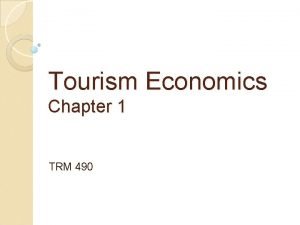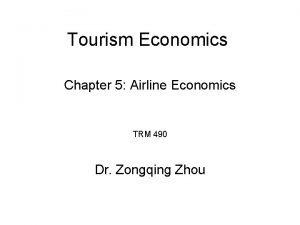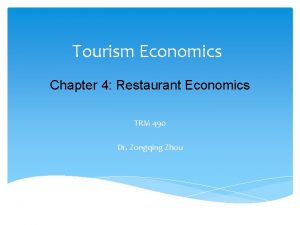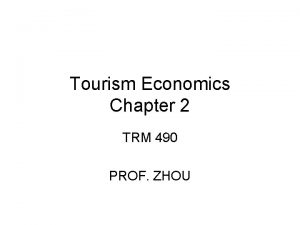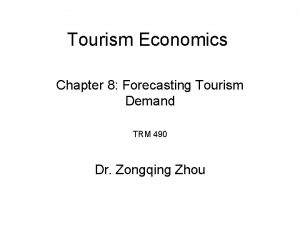Tourism Economics Chapter 3 Hotel Economics TRM 490









- Slides: 9

Tourism Economics Chapter 3: Hotel Economics TRM 490 Dr. Zongqing Zhou

Chapter 3: Hotel Economics (1) • Public lodging reflects general economy, especially local economy. • Heavily capitalized public lodging is as much a business of real estate and finance as it is of lodging operations • Hotel economy is a cyclical business • Overbuilding is a problem • Lodging industry: hotels, motels, all suites, resorts, conference centers, inns, bed-andbreakfasts, timeshares and retirement homes with meals and other services

Chapter 3: Hotel Economics (2) • Some important statistics – – – International hotel room growth rate: 2. 5% US account for one quarter of the world hotel rooms Europe accounts for 45%. US lodging business represents 1% of GNP More and more lodging chains are getting out of the ownership business (see Figure 3 -1) – The ownership of the lodging chains as well as names of the lodging properties keeps changing (compare Fig. 3 -1 with the handout).

Chapter 3: Hotel Economics (3) • Hotel Income: – Hotel income derives from operations and from franchise fees and management fees in some cases. – Developers get income from building and then selling the properties. • Franchise fees: up to 9 % which can translate into a 20% room revenues increase for the franchised hotel. • Franchising (for franchisors) is about 25% more profitable than building or operating hotels, since franchisors are largely risk-free and could remove the franchise if the franchisee failed to make fee payments or live up to the franchise agreement.

Chapter 3: Hotel Economics (4) • Financial problems: – Cycles of overbuilding – Subject to the whims of the economy; occupancy rise in prosperity, falls in recession (for, example, the recession that started in 1989 kept hotel occupancies low even though hotel rates were stable or declined. – 1980 s, foreign investors jumped into the US market due to cheap American dollars – Supply outpaces demand causing large debts that interest payments outgrow income even with relatively high occupancy and good management. – By the end of 1993, overbuilding stopped, but thousands of rooms had been taken off the market. The average number of employees per 100 guest rooms dropped from 70 to 50. – Some hotel developers in the 1980 s profited big time (see page 60, Mr. Hemmeter, for details).

Chapter 3: Hotel Economics (5) • Kinds of Hotels – Hotel can be classified according to • Rate structure • Location • Type of guests – Rate structure • Budget hotel such as Motel 6 often hiring a husband wife to run the property • Limited service properties such as Comfort Inn, Hampton Inns and La Quinta chains (the basic Hampton Inn costs about $31, 000, not including land, a room to build, compared to $80, 000 or more a room for a full-service business hotel. • The upscale such as Hiltons, Hyatts, Sheratons, and Marriotts, full service hotels with at least one restaurant. Labor costs are high, about 34 to 38 % of gross income. • Resort hotels can be any properties that offers sports facilities. • Megahotels are those with 1000 or more rooms. MGM grand Hotel and Theme Park in Las Vegas contains over 5000 rooms, claimed to be the world biggest hotel when it was built. Of the 151 megahotels in the world in 1991, 11 were in China. • Trophy hotels are luxury hotels in prestigious locations were bid up to prices that broke all valuation rules. The reasons for thee astronomical prices are said to involve the egos of the buyers and the fact that over time the land will exceed the purchase price. Hotel chain presidents buy or operate trophy properties partly because they bring status to the entire chain

Chapter 3: Hotel Economics (6) • Classification of hotels according to structure (cont. from previous page) – Large luxury hotels such as the Waldorf Astoria in New York City and the Ritz of Paris cater to high-level business and affluent pleasure travelers. – Casino Hotels are different from the usual commercial hotel • Provide glamour, entertainment, and excellent, yet inexpensive, food and beverage • As of 1994 Las Vegas casinos the largest proprietor in the world with 86, 000 hotel rooms as compared to 79, 000 rooms in Orlando. • Profits for casino hotels can be enormous, for example, up to 40% of Hilton Hotels’ profit is taken from its Las Vegas hotels. • Operating a casino hotel is more complicated than the usual hotel. Security is the number one issue.

Chapter 3: Hotel Economics (7) • Casino visitors and conventioneers behavior: – – – – – Visitors spend nearly $500/person per visit Conventioneers spend nearly $1000/person per visit The high-roller’s average bit is between $150 and $250. The average slot machine player bets $3 per pull and averages 300 lever pulls on a machine The total input in each machine is therefore $900 per player. Casinos make between 5 to 8 percent profit on each machine 55% of the total dollars bet in a casino is in the slot machines, yielding an average of 80 percent of a casino’s profit. The remaining 45% of the bets placed (on blackjack, roulette, etc. ) only yield 20% of the profit. The Atlantic City attracts busloads of gamblers (1000 to 1500 charter buses) who stay between 4 and 12 hours. This proved to be unfortunate for the city which has very little economic benefit.

Chapter 3: Hotel Economics (8) • Factors related to the volume of casino gambling: – The regional and national economy, especially those regions close to the casinos (California is believed to provide half, or more, of the visitors to Las Vegas and Reno) – The national sentiment for legalized gambling which, in the 1990 s, has been increasingly tolerant about gambling in its many forms – Airfares, and the cost and availability of gasoline – Exchange rates – Casino marketing and glamour – The numbers of retired people who casino gamble is rising










